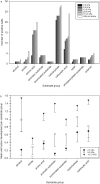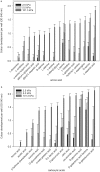Metabolic fingerprints of Serratia liquefaciens under simulated Martian conditions using Biolog GN2 microarrays
- PMID: 30356072
- PMCID: PMC6200771
- DOI: 10.1038/s41598-018-33856-3
Metabolic fingerprints of Serratia liquefaciens under simulated Martian conditions using Biolog GN2 microarrays
Abstract
Microorganisms growing at atmospheric pressures of 0.7 kPa may have a significant impact on the search for life on Mars. Data on their nutrient requirements in a simulated Martian environment are required to ascertain both the potential risk of forward contamination and the potential of past or present habitability of Mars. Serratia liquefaciens can grow at concomitant conditions of low pressure, low temperature, and anoxic atmosphere. Changes in the metabolic fingerprint of S. liquefaciens grown under varying physical conditions including diverse atmospheric pressures (0.7 kPa to 101.3 kPa), temperatures (30 °C or 0 °C), and atmospheric gas compositions (Earth or CO2) were investigated using Biolog GN2 assays. Distinct patterns for each condition were observed. Above 10 kPa S. liquefaciens performed similar to Earth-normal pressure conditions (101.3 kPa) whereas below 10 kPa shifts in metabolic patterns were observed. The differences indicated a physiological alteration in which S. liquefaciens lost its ability to metabolize the majority of the provided carbon sources at 0.7 kPa with a significant decrease in the oxidation of amino acids. By measuring the physiological responses to different carbon sources we were able to identify nutritional constraints that support cellular replication under simulated shallow Mars subsurface conditions.
Conflict of interest statement
The authors declare no competing interests.
Figures






Similar articles
-
The Hypopiezotolerant Bacterium, Serratia liquefaciens, Failed to Grow in Mars Analog Soils under Simulated Martian Conditions at 7 hPa.Life (Basel). 2020 May 26;10(6):77. doi: 10.3390/life10060077. Life (Basel). 2020. PMID: 32466370 Free PMC article.
-
Transcriptomic responses of Serratia liquefaciens cells grown under simulated Martian conditions of low temperature, low pressure, and CO2-enriched anoxic atmosphere.Sci Rep. 2018 Oct 8;8(1):14938. doi: 10.1038/s41598-018-33140-4. Sci Rep. 2018. PMID: 30297913 Free PMC article.
-
Effects of simulated Mars conditions on the survival and growth of Escherichia coli and Serratia liquefaciens.Appl Environ Microbiol. 2010 Apr;76(8):2377-86. doi: 10.1128/AEM.02147-09. Epub 2010 Feb 12. Appl Environ Microbiol. 2010. PMID: 20154104 Free PMC article.
-
Life on Mars: chemical arguments and clues from Martian meteorites.Extremophiles. 1998 Aug;2(3):313-9. doi: 10.1007/s007920050074. Extremophiles. 1998. PMID: 9783179 Review.
-
Toward Martian agriculture: responses of plants to hypobaria.Life Support Biosph Sci. 2002;8(2):103-14. Life Support Biosph Sci. 2002. PMID: 11987302 Review.
Cited by
-
The Hypopiezotolerant Bacterium, Serratia liquefaciens, Failed to Grow in Mars Analog Soils under Simulated Martian Conditions at 7 hPa.Life (Basel). 2020 May 26;10(6):77. doi: 10.3390/life10060077. Life (Basel). 2020. PMID: 32466370 Free PMC article.
-
High-throughput screening carbon and nitrogen sources to promote growth and sporulation in Rhizopus arrhizus.AMB Express. 2024 Jun 28;14(1):76. doi: 10.1186/s13568-024-01733-0. AMB Express. 2024. PMID: 38942930 Free PMC article.
-
Addition of anaerobic electron acceptors to solid media did not enhance growth of 125 spacecraft bacteria under simulated low-pressure Martian conditions.Sci Rep. 2020 Oct 26;10(1):18290. doi: 10.1038/s41598-020-75222-2. Sci Rep. 2020. PMID: 33106561 Free PMC article.
-
Microbial Communities in Saltpan Sediments Show Tolerance to Mars Analog Conditions, but Susceptibility to Chloride and Perchlorate Toxicity.Astrobiology. 2022 Jul;22(7):838-850. doi: 10.1089/ast.2021.0132. Epub 2022 Jun 22. Astrobiology. 2022. PMID: 35731161 Free PMC article.
References
-
- Kminek G, et al. Report of the COSPAR Mars Special Regions Colloquium. Adv. Space Res. 2010;46:811–829. doi: 10.1016/j.asr.2010.04.039. - DOI
Publication types
MeSH terms
Substances
LinkOut - more resources
Full Text Sources
Molecular Biology Databases
Miscellaneous

